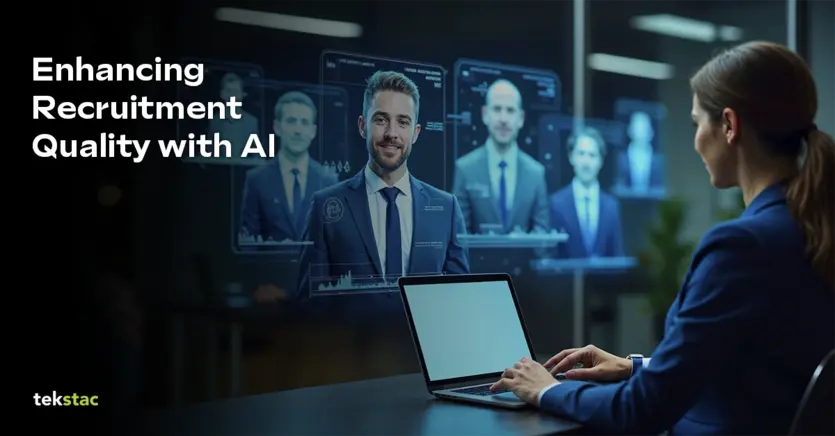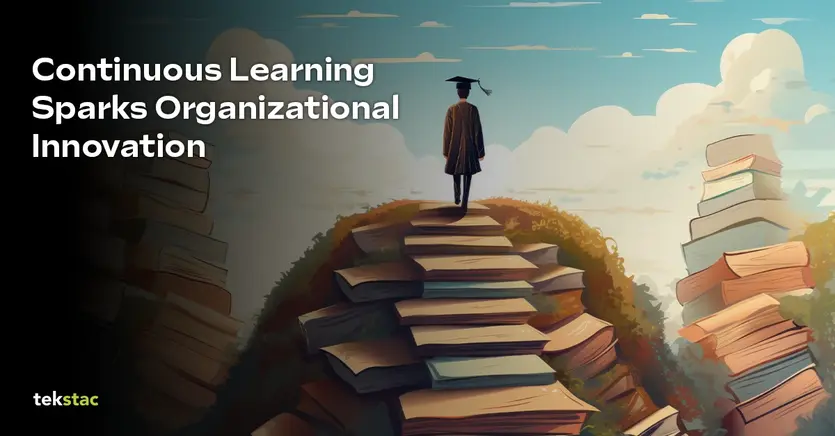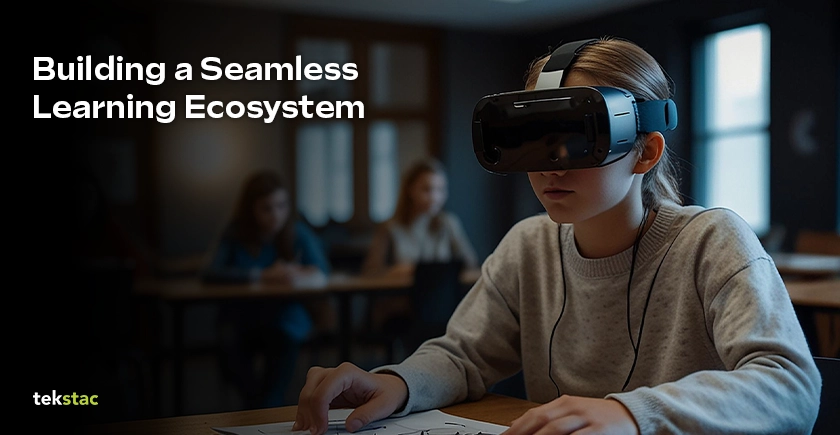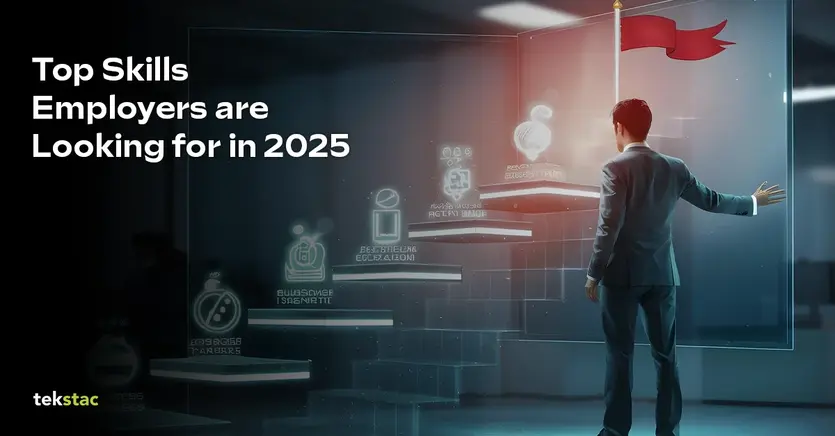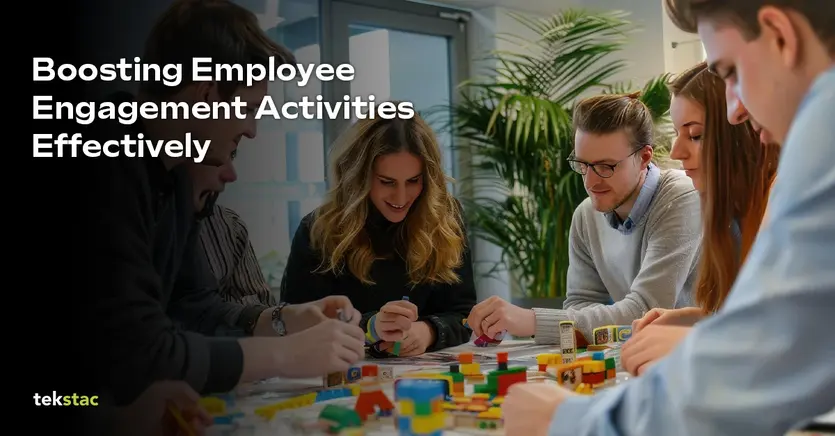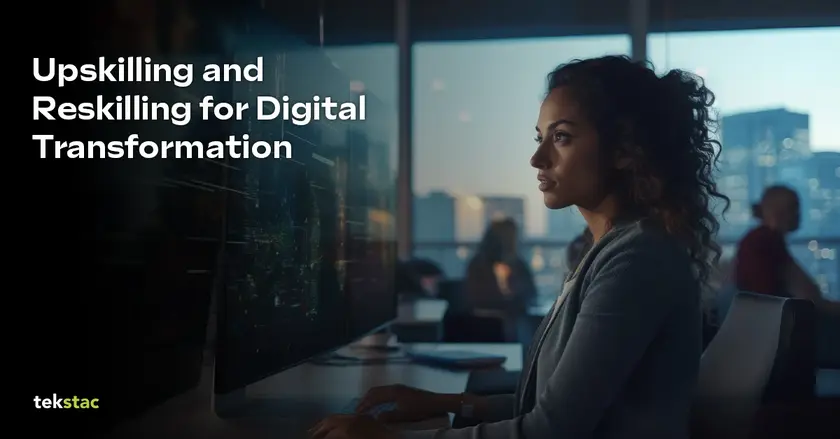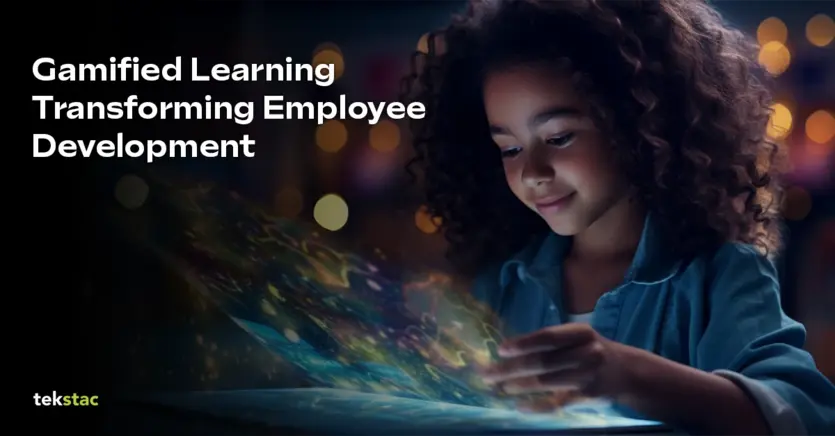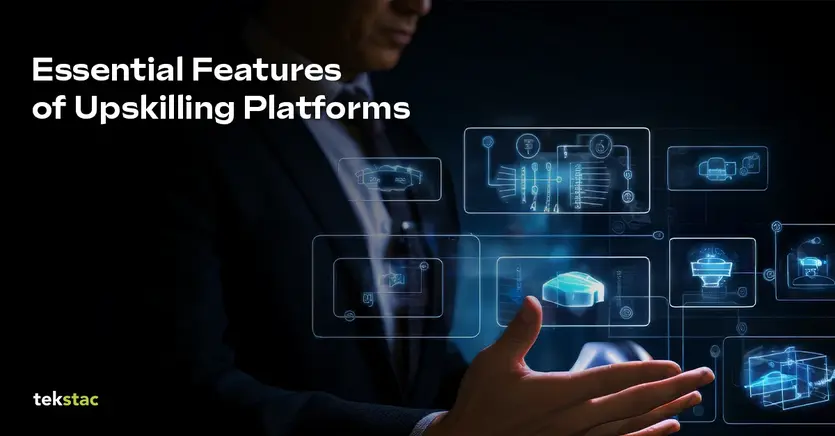Why AI in Recruitment Is the Future of Hiring Excellence
AI recruitment is fundamentally transforming how companies attract and hire talent—disrupting traditional methods and introducing faster, more intelligent hiring solutions. From speeding up shortlisting to aligning candidates precisely with job roles, AI tools are streamlining recruitment workflows and unlocking new levels of efficiency.
Yet, like any transformative innovation, AI in recruitment brings challenges that require thoughtful implementation.
Today’s recruiters face a delicate balancing act: leveraging advanced AI tools while preserving fairness, empathy, and the human connection in hiring decisions.
When applied responsibly, AI in recruitment helps organizations identify top talent, reduce bias, and foster inclusive workplaces—while keeping the human touch at the core of talent acquisition.
The Current Landscape of AI in Recruitment
Artificial intelligence has shifted from being a futuristic idea to an everyday reality in hiring practices. By mid-2023, around 19% of HR leaders were testing out generative AI in their recruitment efforts. Fast forward to 2024, and that number has nearly doubled to 38%.
This remarkable growth underscores the shifting mindset toward AI in recruitment as an indispensable tool.
Why such a rapid surge?
It’s simple: AI eliminates tedious tasks, refines candidate analysis, and accelerates hiring timelines.
In today’s fast-paced talent market, where every second counts, AI in recruitment offers a clear advantage. It’s no longer a matter of “if” companies will adopt AI but rather “how” they can leverage it to maintain a competitive edge.
How AI Is Redefining the Future of Hiring
AI is transforming recruitment by handling repetitive tasks like resume screening, candidate outreach, and success predictions.
Advanced tools operate around the clock, keeping candidates engaged while offering recruiters the insights needed to make smarter, data-driven decisions.
AI in recruitment isn’t about replacing recruiters—it’s about freeing them to focus on building genuine connections and making strategic decisions.
The result? A recruitment process that’s faster, smarter, and more impactful.
AI in Recruitment: Key Benefits for Talent Teams
AI offers undeniable advantages to organizations ready to embrace it. Let’s break these benefits into actionable insights for recruiters.
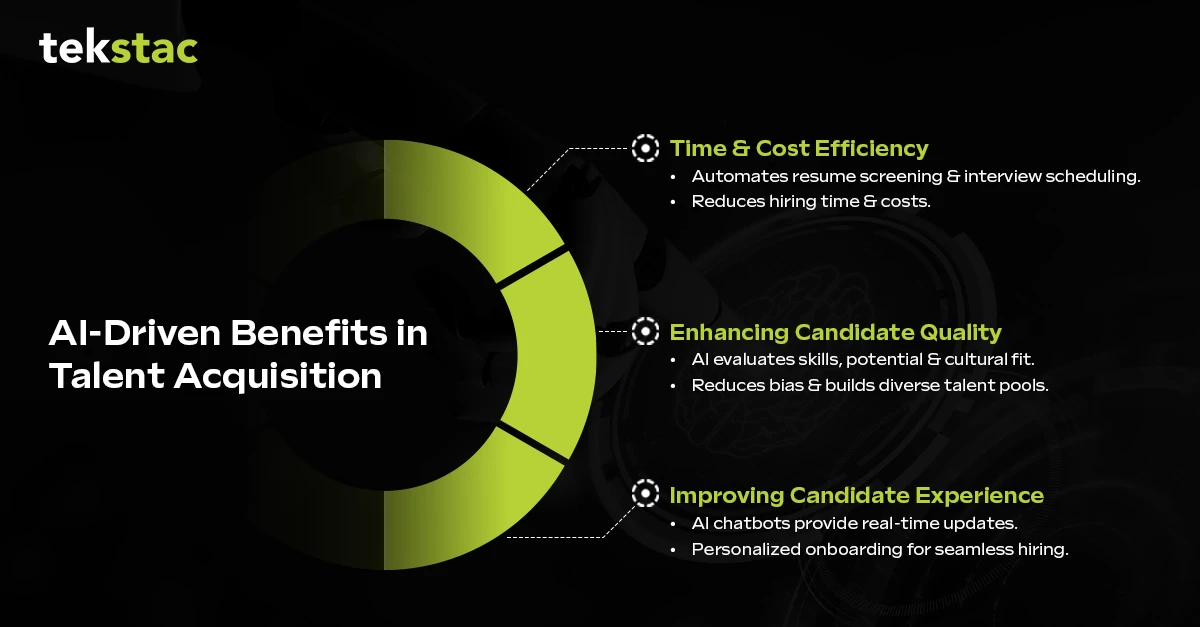
1. Time and Cost Efficiency
Hiring can feel like an endless cycle of screening resumes, scheduling interviews, and following up with candidates. AI automates these tasks, transforming the process entirely.
By pre-screening applicants and utilizing chatbots for real-time updates, AI in recruitment speeds up hiring while cutting costs.
This allows recruiters to zero in on what matters most—connecting with the right talent.
2. Enhancing Candidate Quality
AI tools dig deeper than traditional methods, evaluating not just skills but also potential and cultural fit. Advanced psychometric tests, for instance, measure cognitive abilities and personality traits to predict a candidate’s likelihood of success.
With AI in recruitment, organizations reduce unconscious bias and create diverse, high-quality talent pools. Data-driven insights ensure every candidate gets a fair shot, leveling the playing field in an unprecedented way.
3. Improving Candidate Experience
Lengthy or chaotic hiring processes often drive top candidates away. AI solves this by keeping candidates informed through chatbots and offering personalized onboarding experiences.
For example, AI in recruitment tailors onboarding plans to suit individual roles and preferences, creating a seamless and engaging start for new hires. This makes the hiring journey smooth and effective for everyone involved.
Challenges and Considerations: Navigating AI’s Limitations
Despite its benefits, AI isn’t without its limitations. Missteps can lead to inefficiencies or harm a company’s reputation.
1. Algorithmic Bias
AI is only as good as the data it learns from. Biased training data can lead to discriminatory outcomes, as seen with Amazon’s hiring tool that unintentionally favored male applicants.
To combat this, regular audits and diverse datasets are essential to ensure AI in recruitment promotes fairness and inclusivity.
2. Loss of Human Touch
AI lacks the human touch needed to build trust and meaningful connections between recruiters and candidates.
Over-relying on AI can make the hiring process feel cold and impersonal.
The solution?
Let AI manage repetitive tasks, freeing up recruiters to focus on interviews, negotiations, and fostering relationships—areas where human interaction makes all the difference.
3. Adoption Costs
AI tools typically come with high upfront costs and require significant training to implement effectively.
For smaller companies with irregular hiring needs, the return on investment might not make financial sense.
The solution?
Focus on adopting AI for specific, high-impact use cases where its benefits—like efficiency and accuracy-clearly outweigh the costs.
Future Trends: What Lies Ahead for AI in Recruitment
As technology continues to advance, its role in hiring is set to grow even further. Here’s a glimpse into what the future holds for recruitment and AI-driven processes:
1. Generative AI in Candidate Engagement
Generative AI is quickly becoming a powerful ally for recruiters, streamlining their work and enhancing connections with candidates.
From drafting compelling job descriptions to crafting personalized outreach emails, these tools are transforming how recruiters engage.
Tools like ChatGPT can analyze a job description alongside a candidate’s resume and provide a concise summary of why the individual is a strong match for the role.
2. Skills-First Hiring
The focus on degrees is fading, with skills taking center stage in hiring. LinkedIn data shows that removing degree requirements from job postings can expand talent pools by 36%.
Skills-based hiring not only broadens candidate pools but also encourages diversity, allowing companies to discover talent they might have previously overlooked.
3. AI-Powered Workforce Planning
AI is reshaping how companies plan for the future. It doesn’t just track labor market trends—it predicts them, giving organizations a clear advantage.
With workforce analytics, businesses can spot skills gap before they become problems and decide whether to upskill existing teams or hire fresh talent. It’s like having a crystal ball for smarter, faster decision-making.
Best Practices for AI Implementation in Recruitment
For organizations looking to embrace AI, the key to success is a thoughtful and strategic implementation.
Upskill Your Team
In today’s changing hiring environment, giving recruiters the tools to confidently work with AI isn’t just helpful—it’s essential. Companies are going beyond simple training to truly equip their teams with the skills they need to thrive in a tech-driven world.
Instead of spending hours on repetitive tasks like sorting resumes or scheduling interviews, recruiters can focus on meaningful conversations with candidates and finding the perfect fit for each role. That’s the power of blending human insight with smart technology.
It’s not about replacing the personal touch—it’s about enhancing it. Businesses that prioritize preparing their teams today are positioning themselves to excel in tomorrow’s competitive hiring market.
Adopt Ethical AI Practices
Transparency and accountability are key. Ethical AI ensures candidate data is handled responsibly and that algorithms are free from bias.
Measure Success
If you want to truly evaluate how AI is transforming recruitment, focus on the metrics that matter most:
- Time-to-fill: How quickly can you fill open positions?
- Candidate satisfaction: Are candidates happy with the hiring experience?
- Quality of hire: Are you consistently finding the right fit for each role?
These metrics provide real insights into AI’s effectiveness—whether it’s speeding up processes, improving the candidate experience, and ultimately helping you secure the best talent for your team.
Conclusion: Embracing the AI Revolution in Recruitment
AI is no longer just an addition to the recruitment process—it’s the backbone of modern hiring strategies. Its ability to simplify workflows, improve candidate quality, and boost efficiency makes it essential for organizations aiming to stay ahead in a competitive landscape.
However, the human touch remains irreplaceable. When AI’s strengths are combined with recruiter expertise, the hiring process becomes not just efficient but also inclusive and deeply personal.
The future of recruitment is here—smarter, faster, and more dynamic than ever. Ready to lead the change?
👉 Start your AI-powered hiring journey today.
How Continuous Learning Fuels Innovation and Creativity in Organizations?
The most transformative & innovative solutions often stem from a simple yet powerful habit, and that is continuous learning. Whether it’s a tech giant changing the way people connect or startups reinventing customer engagement, learning has been the key to driving progress and reimagining possibilities.
In the ever-evolving world of modern organizations, continuous learning is more than just gaining knowledge: it fosters adaptability, sparks creativity, and fuels innovation. Organizations that prioritize this approach aren’t just keeping up; they’re rewriting the rules of success.
We can see a valid question popping up in your mind!
What makes this continuous learning such a potential catalyst of innovation? Right?
Let’s dive into this question from different angles and examine its influence beyond conventional corporate frameworks.
How a Learning Culture Drives Innovation in Organizations
Every organization has a distinctive culture, a combination of norms, beliefs, and practices that define how things work. When continuous learning becomes embedded in this DNA, it transforms the focus from “fulfilling expectations” to “shaping new realities.”
Imagine this:
- An effective knowledge-sharing workplace sparks curiosity and encourages employees to ask more questions.
- Employees are ready to challenge traditional processes because they possess new-age skills and mindset.
This environment naturally fosters creativity. For instance, when an employee discovers a new AI tool during his tea break and uses it to automate a traditional time-consuming task, they’ve turned learning into innovation thereby improving productivity and business.
How Continuous Learning Shapes a Creative Workforce?
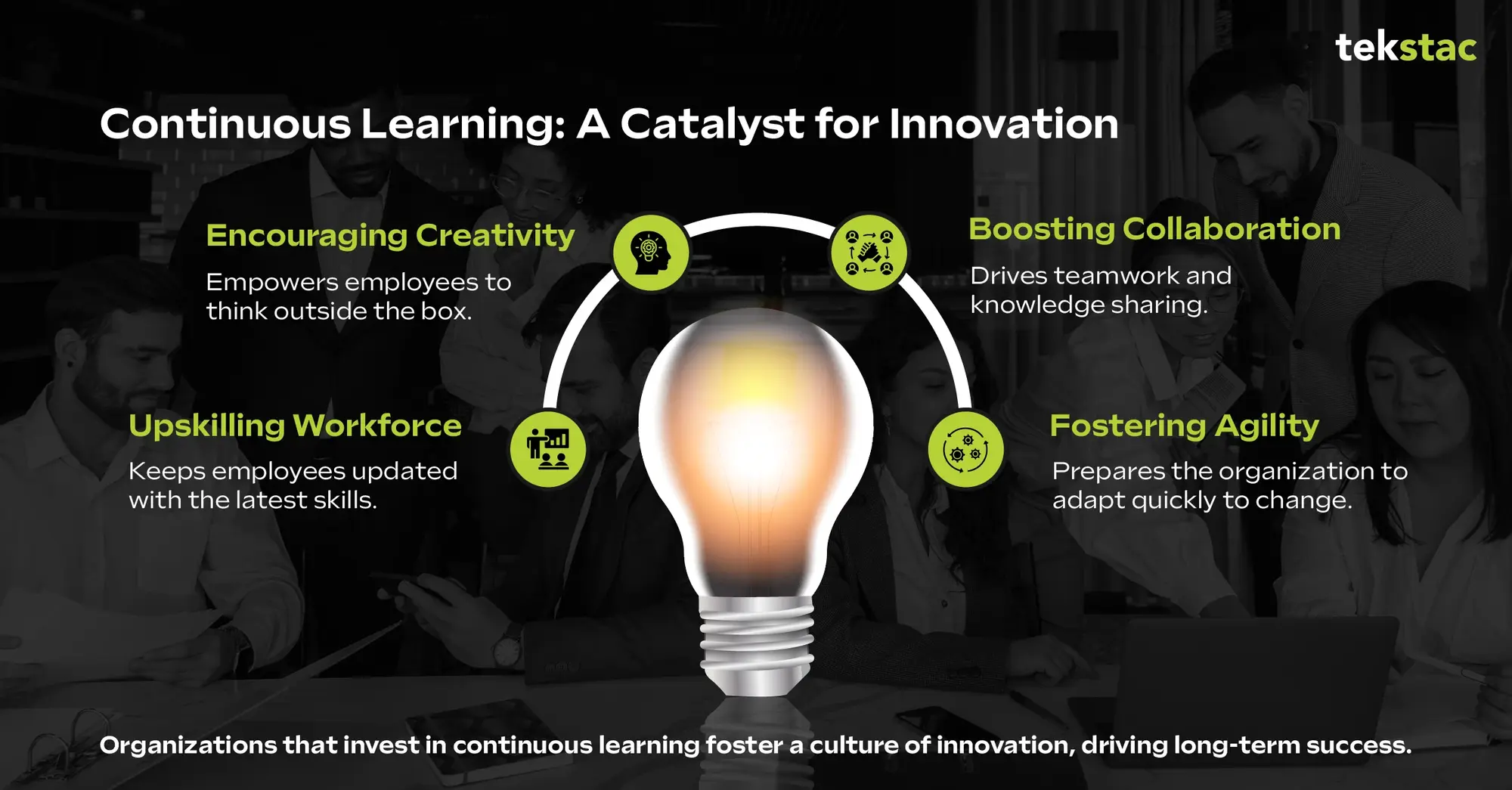
1. Learning Activates Creativity
Creativity is not a magic wand. It flourishes when minds are exposed to fresh ideas and varied experiences. Continuous learning provides the brain with fresh perspectives, enabling employees to connect the dots in unexpected ways.
“You can’t use up creativity. The more you use, the more you have.” – Maya Angelou
Through continuous learning, employees are not just acquiring new skill sets but also developing new ways of thinking.
2. The ‘Unlearning’ Effect
“The illiterate of the 21st century will not be those who cannot read and write, but those who cannot learn, unlearn, and relearn.”- Alvin Toffler
Ironically, learning involves not just acquiring new skills but also shedding old skills. Continuous learners unlearn practices that hinder progress. By doing this, they create opportunities for innovation.
For instance, organizations that adopt agile methodologies often retrain teams to abandon hierarchical decision-making, which results in quicker, collaborative innovations.
3. Creativity Through Collaboration
“Great things in business are never done by one person. They’re done by a team of people.”- Steve Jobs
Continuous learning is rarely a solo pursuit. The best way employees gain the most is through peer-to-peer knowledge sharing or cross-functional activities.
Such interactions break silos, fostering an environment where creativity thrives. Just imagine a marketer teaming up with an IT specialist to leverage machine learning for personalized ad targeting, such synergies are the outcome of shared learning.
4. Embedding Learning Everyday
When employees are allowed to integrate their learning into their daily workflow, it enables them to apply their learning immediately, reinforces retention, and encourages creativity. In upskilling programs, employees gain access to micro-learning tools that easily fit into their daily schedules.
“Knowledge is of no value unless you put it into practice.” – Anton Chekhov
Through continuous learning, employees can refine their approach, apply new insights to ongoing projects, and adapt to any circumstances easily. This fuels creativity and pushes employees to grow and improve.
The Snowball Effect of Learning-Driven Innovation
Continuous learning influences not just an employee or team but the entire organization generating a chain reaction of benefits.
1. Enhanced Employee Engagement
Employees involved in continuous learning are proactive and likely to be more engaged with their work. They are proud of their contributions and never hesitate to go above and beyond to innovate new things.
2. Reputation as a Talent Magnet
Organizations that prioritize and encourage continuous learning attract top talents. Creative professionals look for work environments that support their growth, which in turn fuels the innovation pipeline.
3. Customer-Centric Creativity
When organizations emphasize learning, employees gain a better understanding of the market trends and customer needs. This leads to creative, customer-centric solutions that enhance loyalty and drive success.
Overcoming Challenges in Continuous Learning
1. Time Constraints
Employees mention that time constraints are one of the major obstacles to learning. Organizations can resolve this issue by incorporating learning into the everyday workflow, using methods like microlearning sessions, bite sized learning modules or on-demand training sessions.
2. Resistance to Change
Some employees may be hesitant to engage in continuous learning because they feel comfortable with their existing skills. To eliminate this, it is important to highlight the practical benefits learning brings to the table, such as career growth and improved problem-solving capabilities.
3. Measuring ROI
To validate investments in continuous learning, organizations should assess its impact on performance, innovation, and business outcomes. Metrics such as skill acquisition rates, project achievements, and employee engagement levels can effectively demonstrate the value of these programs.
Breaking the Mold: Strategies for Continuous Learning
To truly drive innovation, organizations need to repurpose their approach towards learning. Here are a few unconventional strategies to consider:
1. Shadow Learning
Encourage employees to shadow colleagues in different departments within the firm rather than just relying on formal training. This practical exposure ignites creative ways to apply knowledge in new contexts.
For example, a finance employee shadowing a marketing team might uncover innovative budgeting techniques to enhance campaign ROI.
2. Idea Hackathons
Hackathons can be conducted across all departments rather than only for tech teams. Such highly focused, cross-department time-bound sessions enable employees to apply their acquired knowledge and explore out-of-the-box solutions.
Consider a supply chain team designing an AI-powered inventory tool during a two-day hackathon. These events don’t just spark ideas; they motivate employees to go out on a limb and think creatively.
3. Reverse Mentorship
Motivate young minds or new hires to guide senior employees on the latest trends and technologies. This approach not only fosters cross-generational collaboration but also brings new, creative ideas into the decision-making process.
Google’s 20% Rule
Google gives employees the freedom to spend 20% of their time on learning or side projects, sparking groundbreaking innovations like Gmail and Google Maps. This strategy has reshaped the tech industry, proving that creativity thrives when people are given the space to explore!
The Future of Continuous Learning
The next frontier of continuous learning is in harnessing AI and data-driven insights. Personalized learning paths, real-time skill assessments, and immersive VR training are transforming how employees learn and apply knowledge.
By adapting to new learning methods, organizations can not only stay relevant but be an innovative leader in the markets they operate in.
In 2025, continuous learning won’t just be an option; it will be a strategic necessity. As technology transforms industries, fostering a culture of learning is crucial for driving innovation, enhancing problem-solving skills, and helping employees keep up with change.
By embedding continuous learning into the core of organizational culture, businesses not only enhance the creativity of their employees but also the boundless potential of the organization itself.
So, are you ready to fuel your organization’s journey of continuous learning and innovation? The time to start is now.
Continuous Learning FAQs
1. How does continuous learning impact creativity in the workplace?
Continuous learning enhances creativity by exposing employees to new ideas and perspectives, helping them solve problems innovatively. It fosters curiosity, collaboration, and adaptability, driving workplace innovation. Organizations that prioritize learning create a culture where creativity thrives.
2. What are the best strategies to implement a learning culture in organizations?
Organizations can build a learning culture by integrating microlearning, cross-functional collaboration, and knowledge-sharing sessions into daily workflows. Encouraging continuous skill development fosters innovation and adaptability.
3. How can AI-driven learning improve innovation in businesses?
AI-driven learning enhances innovation by providing personalized training, real-time skill assessments, and data-driven insights. It helps employees adapt faster, solve problems creatively, and implement cutting-edge solutions.
4. What is the role of ‘unlearning’ in continuous learning?
Unlearning involves letting go of outdated practices and adopting modern approaches. It helps employees break free from old habits and embrace innovative solutions.
Personalized Learning Paths: The Key to Learning Success
Organizations are evolving faster than ever before, driven by technological advancements and shifting business demands. In this dynamic environment, traditional training approaches fall short of addressing employees’ unique needs and aligning with organizational goals.
As the skill gaps continues to widen, LMS adoption is accelerating, with the market projected to reach $57.43 billion by 2030. Businesses turning to AI-powered LMS platforms are seeing strong ROI—streamlined training, higher employee engagement, and noticeable productivity gains are making a real difference.
Step into the future of enterprise learning with personalized learning paths—modern LMS at its finest! These tailored journeys let employees grow at their pace, fueling personal excellence while driving organizational success.
Personalized learning paths are not just a trend—they’re a strategic imperative for businesses determined to stay ahead in a fast-changing world.
Why Personalized Learning Paths Matter to Enterprise Growth
What sets personalized learning apart is its focus on aligning individual growth with business objectives. Unlike conventional training programs, which often take a generalized approach, personalized learning paths are designed to address specific skills gap and career aspirations.
Think of it as crafting a unique development journey for every employee. For instance, a new hire in sales may start with foundational skills like effective communication and gradually move toward mastering advanced negotiation techniques. Similarly, a tech professional could follow a learning path tailored to their expertise, beginning with coding basics and advancing to specialized fields like cybersecurity or AI.
This structured, goal-oriented approach not only boosts employee engagement but also drives measurable results for businesses, ensuring that workforce development directly supports strategic priorities.
How AI and Analytics Drive Personalized Learning at Scale
Modern LMS platforms harness the power of AI and analytics to deliver truly personalized learning experiences. These technologies work by analyzing a range of data points—such as employee roles, past performance, skill levels, and preferences—and using this information to create adaptive learning paths.
Modern enterprise LMS platforms redefine learning through adaptive personalization, a cornerstone of their success.
Personalized Learning Paths That Adapt to Every Skill Level
One of the standout features of AI-powered LMS platforms is adaptivity. By continuously assessing progress, the system adjusts content delivery to match an employee’s current skill level. For example, if a learner struggles with a particular concept, the system might suggest additional resources or simpler explanations to help them overcome the challenge.
Diverse Learning Formats for Greater Engagement
Adaptability is another key component. Employees learn best in different ways—some prefer videos, while others thrive on interactive exercises or written content. Modern systems cater to these preferences by offering diverse formats such as gamification, bite-sized modules, and even immersive VR experiences.
This combination of adaptability and adaptivity not only enhances the learning experience but also ensures employees stay engaged and motivated throughout their development journey.
Overcoming Challenges in Implementing Personalized Learning
While the benefits of personalized learning are undeniable, businesses often face challenges in implementing these systems effectively. Common hurdles include employee resistance, scalability issues, and difficulty in measuring ROI.
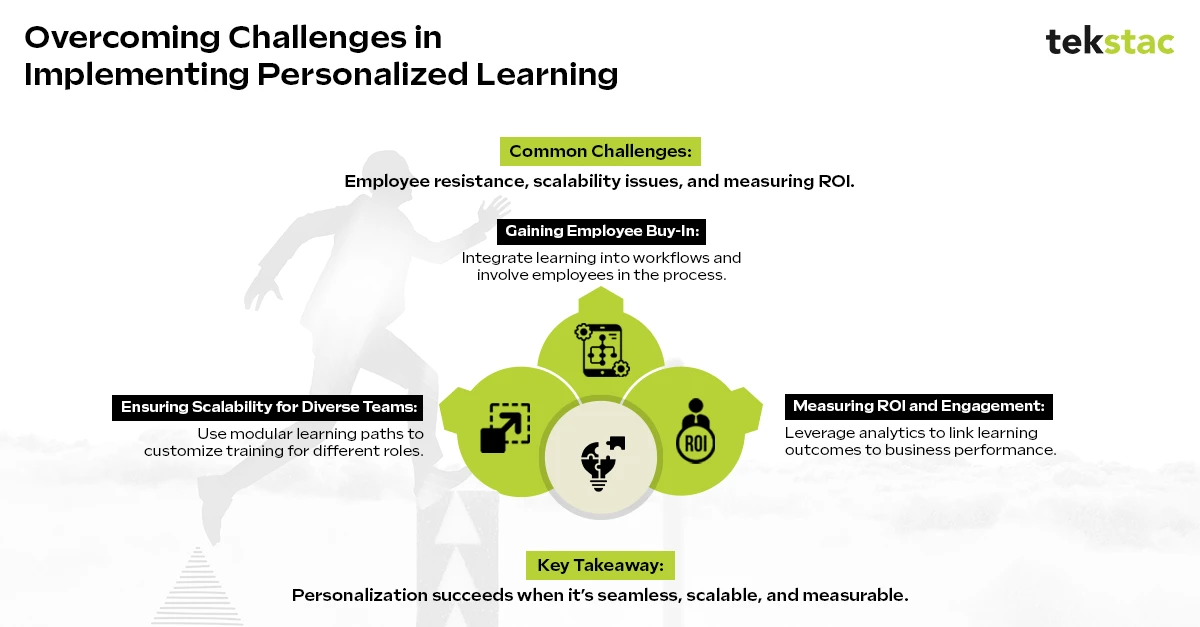
1. Gaining Employee Buy-In
For many employees, personalized learning can initially feel like just another task on their to-do list. Resistance often stems from a lack of understanding about how these programs benefit their careers.
To win employees over, businesses must position personalized learning as a tool for growth rather than an obligation. Integrating it into existing workflows—like ongoing skill-building initiatives or project timelines—can make it feel less like a disruption and more like a natural part of their workday. Involving employees in the design process also helps, as they’re more likely to embrace systems that reflect their input and needs.
2. Ensuring Scalability for Diverse Teams
As organizations grow, they often struggle to scale training programs to meet the needs of diverse roles and departments. A rigid system can quickly become outdated or underutilized.
Scalable, modular learning paths are the answer. These systems allow businesses to customize training content based on individual or team requirements. For instance, a consulting firm can create separate pathways for entry-level analysts and senior consultants, ensuring that each group receives relevant training without unnecessary overlap.
3. Measuring ROI and Engagement
Leadership often seeks tangible proof that training investments are yielding results. Without clear metrics, it’s challenging to justify continued investment in personalized learning initiatives.
Advanced analytics tools within LMS platforms can tie learning outcomes to business metrics like productivity, employee satisfaction, and retention. Regular assessments and feedback loops also ensure that training remains aligned with evolving business goals.
The Impact of Learning Pathways on Employee Development
Learning pathways are more than just a roadmap—they’re a strategic enabler for employee growth and organizational success. By breaking down complex learning objectives into manageable steps, these pathways make skill-building more accessible and less intimidating.
For example, a marketing professional might start with general strategies like brand marketing and gradually move on to specialized topics like SEO, social media analytics, or email campaign optimization. This structured approach builds confidence, keeps employees focused, and ensures continuous progress.
From a business perspective, learning pathways lead to better-aligned teams that are equipped to tackle challenges head-on. Employees gain the skills they need to excel in their roles, while companies benefit from a more skilled and motivated workforce.
Designing the Future of Corporate Learning
The future of corporate learning lies in flexibility, accessibility, and data-driven customization. Personalized learning paths integrate seamlessly into this vision, transforming LMS platforms from simple training tools into strategic assets.
Key Features That Drive Success
- Mobile-First Designs: Employees can access training anytime, anywhere, ensuring uninterrupted learning even in a remote or hybrid work environment.
- Gamification and Interactive Elements: Features like leaderboards and challenges keep employees engaged and motivated.
- Intelligent Feedback Mechanisms: Continuous assessments provide actionable insights, allowing businesses to refine their learning strategies.
These features ensure that learning systems remain dynamic and responsive, capable of adapting to changing business priorities and employee needs.
Fueling Business Growth with Personalized Learning Solutions
Personalized learning paths are more than a feature—they’re a transformative approach to employee development. By leveraging the power of AI, advanced analytics, and adaptive technologies, modern enterprise LMS platforms deliver training that’s as dynamic as today’s business environment.
For employees, these systems offer a clear path to growth, building confidence and enhancing job satisfaction. For organizations, they represent a strategic advantage, ensuring that workforce development aligns with business objectives.
Ready to transform your learning strategies? Schedule a demo today and see how personalized learning paths can elevate your workforce to new heights!
Building a Learning Ecosystem: From Onboarding to Upskilling
In today’s fast-paced business environment, staying competitive means equipping your workforce with the right skills at the right time. For organizations like yours, building a seamless learning ecosystem is no longer optional—it’s a strategic necessity.
A robust learning ecosystem not only bridges critical stages like onboarding and upskilling but also establishes a foundation for continuous growth and innovation.
The Core Elements of Modern Learning Ecosystems
A learning ecosystem serves as the foundation for modern employee development, seamlessly blending three critical elements: technology, content, and culture. Each of these components plays a unique role, yet their real power lies in how they work together to create a cohesive system.
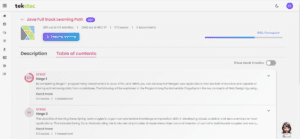
In modern learning tech ecosystems, technology acts as the engine—streamlining access to learning content, tracking real-time progress, and delivering analytics that power strategic learning decisions. As highlighted in Forrester’s 2024 evaluation, platforms like LMS and LXP enable employees to shape their learning journeys through centralized, user-friendly systems.
With advancements like generative AI (GenAI) and seamless business integrations, these tools are transforming learning into a strategic driver of measurable outcomes, equipping organizations to stay agile and future-ready.
Content is the heart of the ecosystem, ensuring relevance and engagement. Whether it’s bite-sized microlearning modules that fit into a packed schedule or immersive simulations that mimic real-world scenarios, effective content meets learners where they are and keeps them motivated to grow.
But technology and content can only go so far without the right culture. A culture that prioritizes growth, celebrates learning, and encourages employees to acquire new skills creates the foundation for sustained success.
Connecting Onboarding and Upskilling in a Unified Learning Ecosystem
By 2030, 85 million jobs could go unfilled globally, with 71% of CEOs citing the talent shortage as their top challenge. This highlights an urgent need for companies to integrate onboarding and upskilling into a seamless journey. Forward-thinking companies are replacing external hiring with internal talent development—leveraging integrated learning ecosystems to reskill and upskill employees for long-term sustainability.
Combining these processes equips employees with modern skills while aligning them with company goals, fostering productivity and retention.
For instance, Amazon’s $1.2 billion Upskilling 2025 initiative showcases the impact of strategic training investments.
Aligning onboarding with upskilling builds a future-ready workforce—making it essential for today’s competitive landscape.
How Learning Tech Ecosystems Personalize the Employee Experience
In today’s fast-paced business environment, technology has become the linchpin in transforming learning ecosystems into dynamic, personalized experiences. Yet, many organizations grapple with fragmented systems, outdated tools, and data silos that stifle their ability to deliver tailored learning journeys.
These inefficiencies not only disrupt the flow from onboarding to upskilling but also limit the potential of learning programs to meet evolving workforce demands.
A fully optimized learning tech ecosystem connects LMS, LXP, and analytics platforms—breaking down silos and enabling personalized, data-driven learning pathways for every employee. This integration fosters an environment where employees transition smoothly through personalized learning paths, blending tutorials, collaborative projects, and on-the-job training into a unified experience.
For L&D teams, centralized data becomes a strategic asset—powering precise, data-driven decisions to enhance training outcomes and align with business objectives.
Overcoming Barriers to Building a Learning Ecosystem
While implementing a learning ecosystem unlocks significant potential, it’s often met with hurdles like employee resistance and difficulty in proving ROI. Yet, with a carefully planned approach, these challenges can be transformed into stepping stones toward success.
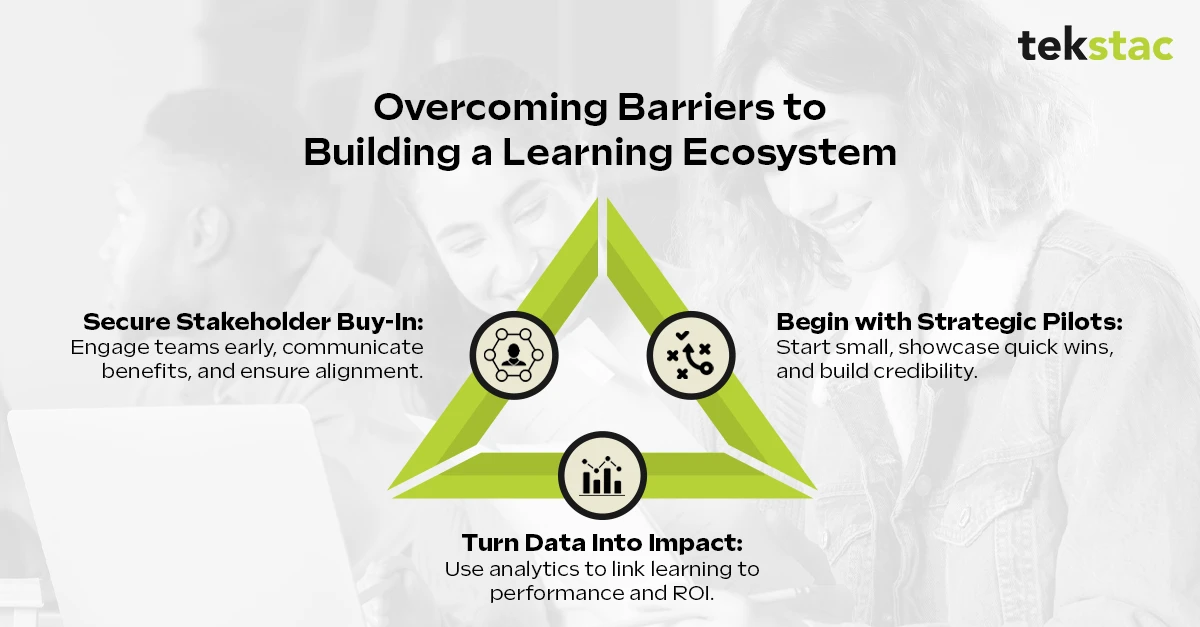
1. Begin with Strategic Pilots
Pilot programs are an ideal starting point, enabling organizations to introduce the ecosystem gradually. This controlled rollout not only minimizes risk but also establishes credibility by showcasing early wins, building trust among stakeholders.
2. Secure Stakeholder Buy-In Early
Engaging employees, business teams and leadership from the outset is essential. Open dialogue about the system’s long-term benefits—improved productivity, skill development, and operational efficiency—fosters alignment and ensures smoother adoption.
3. Turn Data Into Impact
Analytics act as the bridge between strategy and outcomes. By linking learning initiatives to measurable performance gains, organizations can demonstrate ROI with clarity, justifying ongoing investment while driving confidence across all levels.
IBM implemented a comprehensive learning system that significantly enhanced employee performance. Studies revealed that time spent on learning and the achievement of internal learning credentials, known as “badges,” were positively associated with meeting sales targets and career advancement.
Harnessing Trends to Redefine Learning Ecosystems
Emerging trends such as microlearning, hybrid work models, and AI-driven analytics are revolutionizing how organizations build future-ready workforce.
- Microlearning: This format is redefining traditional training by offering concise, impactful lessons accessible anywhere and anytime. In fast-paced business environments, where time is a scarce resource, these bite-sized modules provide a powerful solution for fostering growth without disrupting productivity.
- Hybrid Work Models: The shift to hybrid work has transformed employee expectations for training delivery. Learning platforms must now cater equally to remote and in-office teams, offering seamless flexibility. Organizations that adapt to these demands enhance engagement and maximize learning outcomes.
The Takeaway
Forward-thinking organizations recognize that workforce agility is the foundation of long-term success. By aligning learning ecosystems with emerging trends and leveraging analytics to guide decision-making, they don’t just prepare for change—they drive it.
Conclusion: Why a Connected Learning Tech Ecosystem Is Your Competitive Edge
In today’s rapidly evolving business landscape, the ability to learn and adapt has become the ultimate competitive edge. A well-designed learning ecosystem not only prepares employees to excel in their current roles but also equips them with the skills needed to navigate future challenges with confidence.
Organizations that successfully align onboarding with upskilling, adopt advanced technologies, and cultivate a culture of continuous learning are the ones best positioned to thrive.
Key Insights on Learning Ecosystems and Workforce Agility
- Companies that implement continuous learning ecosystems see a 46% higher likelihood of achieving industry leadership, according to the PwC Global Workforce Survey.
- AI-driven personalization can increase employee engagement by up to 45%, enabling businesses to enhance learning experiences from onboarding to upskilling.
- Robust onboarding programs can improve retention rates by 82%, demonstrating the need for integrated ecosystems.
Ready to build a connected learning ecosystem that bridges onboarding and upskilling while driving workforce agility?
Tekstac specializes in building cutting-edge learning ecosystems tailored to your organization’s unique needs.
From advanced LMS integrations to personalized microlearning content, we help you drive workforce agility and achieve lasting success.
🔗 Schedule a Demo with Tekstac Today!
What are Skill Gaps: Top Skills Employers are Looking for in 2025
What Are Skill Gaps and Why They Matter in 2025
The job market is rapidly evolving with emerging technologies and automation. These changes are disrupting the workplace on multiple fronts keeping business and HR teams on the hook. According to the World Economic Forum estimates, by 2025, 85 million jobs may be displaced due to changes in the labor division between humans and machines, simultaneously creating 97 million new jobs.
Changing technology is transforming the workplace at an explosive rate. Just as an outdated smartphone struggles to run new apps, a company with outdated skills may fail to meet new market demands. Technological acceleration, particularly due to automation and artificial intelligence, has created a demand for new skills making old ones redundant.
To remain competitive, organizations need to invest in integrated skill development programs for upskilling their workforce. This program should be comprehensive to upgrade employees’ technical and professional competencies.
Top Skills Employers are Looking for in 2025
Here is a list of 6 groundbreaking skills that will be most valuable assets for individuals as well as organizations in 2025.
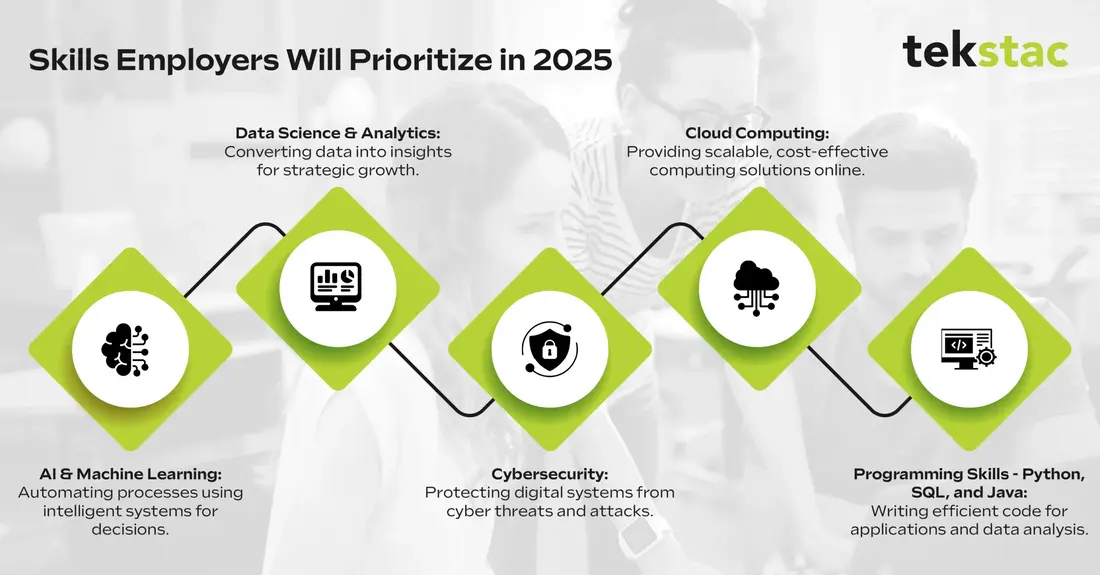
1. AI & Machine Learning
AI and Machine learning, particularly generative AI like OpenAI’s GPT models, are the most in-demand technologies today. These technologies have the power to significantly enhance productivity in the workplace through automation.
More and more new jobs are opening in this field today, and the trend is expected to continue in 2025. However, a significant skill gap exists related to the development, management, and ethical use of AI.
Organizations need employees who know how to integrate AI into their business operations. This knowledge is crucial for any organization to leverage AI to gain a competitive edge. The AI and data skills can be developed through upskilling programs and learning resources.
2. Data Science & Analytics
Data has become one of the critical competencies of business as data-driven decisions offer a competitive advantage. The data analytics field has become vital for businesses due to its ability to offer intelligent insights.
The demand for data science skills is increasing. As per a LinkedIn report, the data science job postings have exhibited a 46% annual growth.
The data science skills are the pivot for customer behavior analysis, predictive modelling, market trend analysis and optimizing operations. There are multiple tools and platforms that must be learned to master data science.
3. Cybersecurity
Data security and compliance have become baseline requirements for most industries as they handle large data. Cybersecurity professionals are needed to identify vulnerabilities and implement security systems while ensuring compliance.
Cybersecurity is a valuable skill in such a business environment that faces heightened cyber threats. There is a growing need for cybersecurity professionals who can ensure data privacy and handle large-scale cyber threats.
In 2025, cybersecurity is likely to remain a valuable skill due to the widening skills gap. Organizations need to develop learning programs to strengthen the security of their data and IT infrastructure.
4. Cloud computing
Cloud computing has become the epic center of modern IT infrastructure. The cloud platforms allow companies to scale up and provide operational agility.
Enterprises are embracing cloud technologies such as AWS, Azure, and others. The demand for professionals with skills in application development and management in cloud environments is increasing.
Organizations need skilled cloud professionals to design resilient and safe cloud infrastructures. These skills can be developed through learning platforms and official training resources.
5. Programming skills- Python, SQL And Java
These three programming skills remain most in demand by employers as modern software development revolves around them. Python plays a key role in data science and artificial intelligence.
SQL is an indispensable element of data analytics and dataset management. While Java is a favorite choice for enterprise management and Android development.
The programmers with expertise in these technical languages are highly valued. Employers particularly value those programmers who can combine this technical expertise with software development and team skills.
6. Blockchain technology
Blockchain technology started from cryptocurrencies and has now become a major force transforming the supply chain and financial aspects of businesses. The demand for this technology has surged as it is considered to be secure in the digital ecosystem.
Blockchain expertise can be developed by gaining an understanding of cryptocurrency basics, distributed ledger technology and blockchain architecture. However, practical skill development requires hands-on experience in the development of blockchain platforms.
Bridging the Skill Gap: Smart Strategies for 2025
Both organizations as well as employees need to manage the skills gap for sustainable growth and development. Embracing learning, sharing knowledge and collaborating is the key to managing the skills gap.
Organizations need to build a learning ecosystem that is comprehensive, secure and scalable. Progressive organizations are leveraging learning platforms to upskill their existing employees to meet future demands.
Learning platforms offer targeted training, auto-evaluate assessments and effective learning interventions. These platforms support a continuous learning environment by covering a broad spectrum of technologies and skills.
Employees can use these platforms to upskill by gaining real-time insights into training programs. The case-study-based learning along with practice labs offered by these platforms enable all round upskilling of employees.
How Tekstac Can Help Close Skill Gaps
The 2025 skill challenge requires a robust learning infrastructure to promote and cultivate a learning culture. It offers an opportunity for those who are willing to learn new skills and aim to apply them in creative ways.
Tekstac, a comprehensive learning platform is a groundbreaking solution for upskilling employees. Its hands-on practice labs and real-world scenarios can make it easy to gain complex technical skills.
Be ready to face the skill challenge, start the upskilling journey today with Tekstac!
Skill Gaps FAQs
1. How can organizations effectively address skill gaps?
Organizations can address skill gaps by investing in continuous learning platforms, offering targeted upskilling programs, and aligning training with future job roles and technologies.
2. Why do skill gaps exist in 2025?
Skill gaps in 2025 exist due to rapid advancements in technology, especially AI and automation. As job roles evolve, many employees lack the up-to-date skills needed for emerging tasks, creating a mismatch between job requirements and workforce capabilities.
3. How do I overcome skill gaps as an employee?
You can overcome skill gaps by actively upskilling through online courses, certifications, and hands-on practice. Focus on high-demand areas like AI, data analytics, and cybersecurity, and choose platforms like Tekstac that offer real-world learning experiences.
4. What skills are employers looking for to close gaps?
Employers in 2025 seek skills in AI and machine learning, data science, cybersecurity, cloud computing, programming (Python, SQL, Java), and blockchain. These skills help businesses adapt to digital transformation and maintain a competitive edge.
How Training Boosts Employee Engagement Activities and Job Satisfaction
How Training Actively Boosts Employee Engagement Activities
Employee involvement is critical to any organization’s success, but creating an environment where employees feel valued, motivated, and connected can be challenging. One of the strategic & effective ways to promote a positive attitude towards future changes & enhance employee engagement activities is through training programs. Training programs not only equip employees with the skills they need to excel but also create a culture of continuous improvement and engagement.
What Are Employee Engagement Activities & Why Do They Matter?
Employee enhancement activities include initiatives aimed at boosting employee morale and strengthening connections & collaboration within the organization. This encompasses a range of activities, including team-building programs, wellness initiatives, in addition to training & development opportunities. The aim is to synchronize employees’ sense of purpose with the company’s mission, ensuring they feel appreciated and contented in their roles.
Training is often underestimated, yet it plays a crucial role in employee engagement activities by enhancing employee morale, collaboration, and alignment. It not only enhances skills but also builds a sense of community and promotes career growth.
How Training Directly Impacts Employee Engagement Activities
Training plays a pivotal role in employee engagement by:
- Enhancing Skillsets: Confidence and commitment of the employees are likely to be high when they possess adequate skills to thrive in their roles.
- Promoting Career Growth: Offering opportunities for upskilling and reskilling highlights a company’s dedication to employee growth, which in turn boosts morale.
- Building Organizational Alignment: Training helps employees develop an awareness of the company’s objectives, standards, and beliefs, thus helping build stronger connections.
A meticulously crafted training program integrates seamlessly into employee engagement activities, establishing a continuous cycle of growth and satisfaction.
Top 4 Benefits of Training for Employee Engagement Activities
1. Boosts Confidence and Competence
Employees feel more capable of working through challenges and performing their duties more efficiently once they have been trained. This confidence minimizes tension and improves overall job satisfaction, which is the key to engagement.
For example, technical training helps employees efficiently use the latest tools and technologies, while soft skills training improves their ability to manage workplace relationships.
2. Encourages Collaboration Through Group Learning
Group training programs promote collaboration and teamwork. Employees gain knowledge from each other, exchange insights, and build bonds that foster positive workplace relationships. This collaborative atmosphere can translate to other employee engagement activities, thus promoting mutual support and fellowship among employees.
3. Provides Opportunities for Recognition
The training typically includes assessments, certifications, or accomplishments that serve as opportunities for recognition. Rewarding your employees’ milestones during the training period reinforces their value and motivates them to participate in other employee engagement activities.
4. Supports Leadership Development
Leadership training helps identify & develop potential leaders in an organization. When employees see a clear line of progression to leadership roles, their determination and motivation scale up. These upcoming leaders can then advocate employee engagement activities, further promoting an environment of positivity and growth.
How Training Impacts Job Satisfaction
Training not only engages employees but significantly impacts their satisfaction.
1. Alignment with Career Goals
When employees are given personalized training specific to their career aspirations, there is a high probability for them to feel contented in their positions. This correlation between personal & professional goals increases commitment and decreases turnover.
2. Reduced Workplace Stress
When employees lack the necessary skills or have unclear job roles, it leads to frustration and stress. Training equips employees with the tools they need to tackle challenges, creating a more composed and fulfilled workforce.
3. Recognition of Employee Value
Conducting training programs emphasizes that an organization values its employees, fostering a sense of appreciation. This, in turn leads to enhanced job satisfaction and encourages employees to actively participate in employee engagement activities.
4. Increased Autonomy
Training empowers employees to take control of their responsibilities and decisions. This freedom increases confidence and enhances job satisfaction as employees feel valued and respected.
Designing Training Programs to Elevate Engagement & Satisfaction
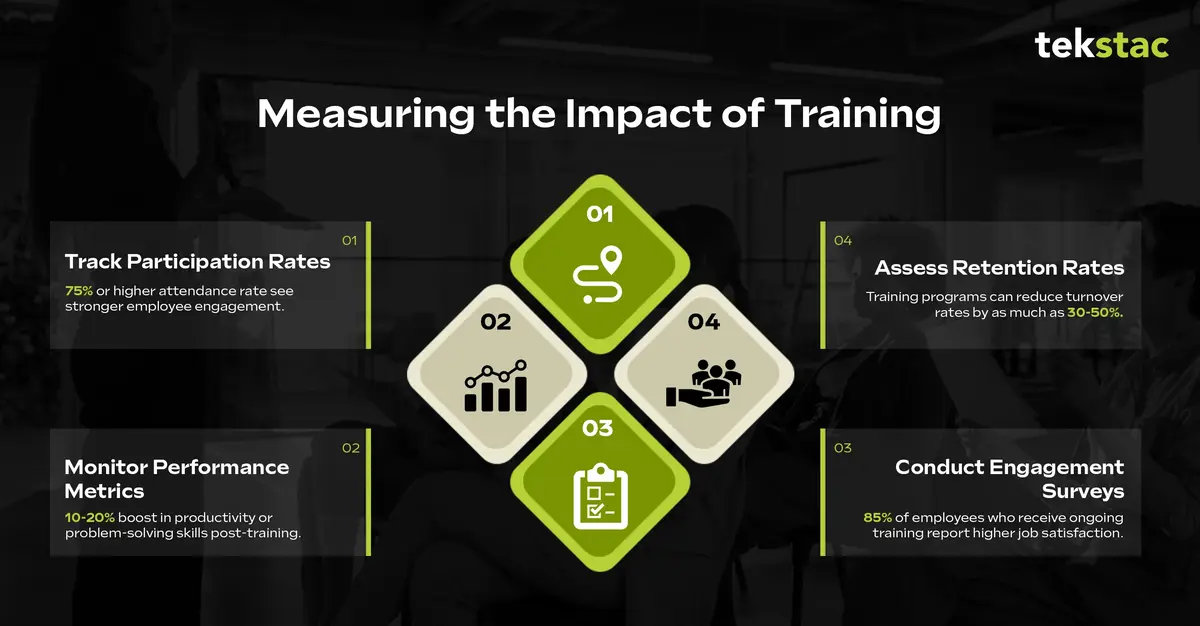
To ensure that training has a powerful influence on employee engagement activities and job satisfaction, organizations have to strategically craft programs.
1. Conduct Needs Assessments
Knowing skills gap and employee career goals are key which can be determined through surveys, interviews, or performance reviews. Then, customize training programs to meet these specific needs.
2. Incorporate Engaging Learning Methods
Use interactive formats such as workshops, gamification, or online modules to keep employees engaged. Group activities and real-world challenges make the learning experience more dynamic and fun.
3. Provide Continuous Learning Opportunities
Training should be more than a one-time affair. Establish a culture of continuous learning where an employee is allowed to regularly access learning materials, attend workshops, and take part in mentorship programs.
4. Link Training to Career Development
Describe clearly how training supports career advancement. Providing certifications, pathways to promotion, or additional responsibilities as a result of training keeps employees engaged and motivated.
5. Embed Training into Employee Engagement Initiatives
Integrate training with other engagement activities, including team-building tasks, cross-functional projects, or health programs, to develop a holistic approach to employee development.
Real-World Examples of How Training Drives Engagement
Leading companies like Google and IBM, known for their robust employee engagement activities, use training as a strategic tool to boost satisfaction and innovation. how:
Google’s Career Development Program
Google has made huge investments in training programs that enable employees to discover roles across departments. This emphasis on growth leads to high levels of engagement and satisfaction.
IBM’s SkillsBuild Initiative
IBM provides employees with continuous learning opportunities via its SkillsBuild platform, motivating them to develop new competencies and feel empowered in their positions.
Conclusion: Why Training Is Key to Employee Engagement Success
Training goes beyond acquiring skills; it’s an investment in employees. By incorporating training into employee engagement activities, organizations create a workforce that is not just proficient but also connected, motivated, and satisfied.
The outcome?
Increased productivity, better collaboration, and a thriving culture.
Embrace the power of training as a key factor of your engagement strategy, and you’ll be amazed to see your organization evolve into a center of innovation and excellence.
Upskilling and Reskilling for Digital Transformation: Preparing Your Team
What is Digital Transformation?
Digital transformation is reshaping how businesses operate—driving innovation, efficiency, and scalability. But to fully embrace this shift, digital upskilling and reskilling employees is essential. Companies must equip their teams with modern capabilities to stay competitive in the evolving digital economy.
Through digital transformation, businesses can minimize costs, achieve data-driven decision-making, increase revenue growth, and enable scalability. For example – Tech giant Amazon has revolutionized its business by using AI-driven robots in warehouses for better inventory management and offering personalized shopping experiences to clientele by incorporating machine learning into its recommendation engine.
Digital transformation is a continuous and long-term journey for organizations, which raises the question of how employees prepare for it. Upskilling and reskilling help navigate digital changes as they facilitate employee engagement and retention, meet industry regulations and compliance, and enhance workforce adaptability. They are also a great way to enhance an organization’s brand value and contribute to being a ‘best place to work’.
Difference Between Upskilling and Reskilling Explained
Suppose a renowned bank decides to adopt AI-based customer service tools like chatbots — In that case, it can upskill by teaching its customer service agents how to leverage chatbots for handling routine queries while solving the complex problems by themselves. The bank can reskill by shifting tellers and back-office staff into specialized roles that require managing digital financial products or customer relationship management.
Understanding the difference between upskilling and reskilling is key to building a future-ready team.
- Upskilling helps employees improve existing skills to adapt to new technologies or workflows.
- Reskilling equips them with entirely new skills for different roles, often required during digital shifts like AI adoption or automation.
Both are strategic components of any digital upskilling training plan.
Upskilling and reskilling are invaluable in developing a sense of loyalty among employees, carving new paths, and increasing the chances of promotions and higher pay scales. They are also a great way to attract new talent, as prospective employees would appreciate a workplace that provides training facilities and helps them ease into their roles steadily.
Digital Upskilling Training: How to Prepare Your Teams
Upskilling and reskilling are essential in creating a focused and well-laid-out approach to training, change management, and building a culture of adaptability.
Assessing skills and identifying gaps
Start your digital upskilling training journey by identifying digital skills gaps through tools like surveys, feedback loops, and AI-powered assessments. This forms the foundation for building personalized development roadmaps for upskilling employees and preparing them for future roles.
Based on the results, companies can create personalized training plans to help employees upskill by adopting new technologies like AI, IoT, or Cloud, improving their project management skills or customer service skills.
Supplementing training with practical experience
Practical experience creates a learning experience amalgamating real-world application, mentorship, and continuous feedback systems. This experience is invaluable in preparing an employee for a different job position. Thus, garnering practical experience is a great way to upskill and reskill.
Here are some ways for organizations to evaluate their employees on their newly acquired skills:
1. Internal projects
Internal projects are an excellent way to help employees test their understanding of concepts and skills in real-time projects and solve organizational-level problems. Hence, they help develop hands-on experience and boost employees’ confidence by putting theory into practice.
For example, A corporate communications specialist who earns certification in digital marketing can identify new platforms to run ad campaigns, offer creative ideas to social media teams, and generate new leads by collaborating with content marketing teams.
2. Cross-functional roles
Cross-function roles enable employees to think from fresh perspectives, delivering creative and impactful solutions. They also help develop a holistic overview of how organizations function across teams and optimize resource use. As a result, employees participating in cross-collaboration roles have a broader picture of how technology supports overall business objectives.
For example, an HR team member undergoing reskilling for digital transformation can collaborate with IT to configure cloud-based HR systems—gaining technical know-how while improving workflow efficiency.
3. Upskilling Employees with Essential Soft Skills
While preparing your team for digital transformation, investing in soft-skill training, such as written and verbal communication skills, leadership, Emotional Intelligence (EQ), and negotiation skills, is also important.
Organizations can conduct soft skill training to help with both upskilling and reskilling by partnering with external agencies for interactive workshops and running micro-learning modules. For example, while employees receive training on new technologies, they conduct short learning sessions focusing on specific soft skills like “communicating effectively for remote work” or “resolving conflicts in digital collaborations.”
4. Fostering Innovation While Upskilling Employees
To embrace digital transformation, organizations need to think differently, which involves encouraging teams to brainstorm, test new tools, and find unique approaches to work. Organizations can also run competitions and innovation-based challenges to offer solutions for issues arising during digital transformation. Follow up these with prototyping initiatives and pilot testing projects to develop hands-on experience and test the viability of innovative solutions through real-time application.
5. Rewards and Recognition
Celebrate your team members’ progression and achievements as they finish training and acquire new skills. Share their success stories and milestones in company newsletters, email campaigns, or company case studies to recognize their contribution to the organization’s digital transformation process.
How AI and Data Analytics can help personalize the learning experience
AI-based customized learning paths
Through Artificial Intelligence-based skilling platforms like Tekstac, organizations can continuously assess and offer tailor-made learning solutions based on the employee’s:
- Patterns in learning behavior and past performance
- Knowledge level, career goals, and learning preferences
- Performance in assignments and quizzes
Predictive analytics for tracking progress
Organizations can integrate data analytics into their learning platforms to identify skills gaps, track progress, and forecast learning needs. Here are some ways through which analytics tools help:
- Assess and offer insights on which aspects employees excel at and where they face challenges
- Analyze overall engagement and completion rates to evaluate employee performance
Challenges in upskilling and reskilling during digital transformation
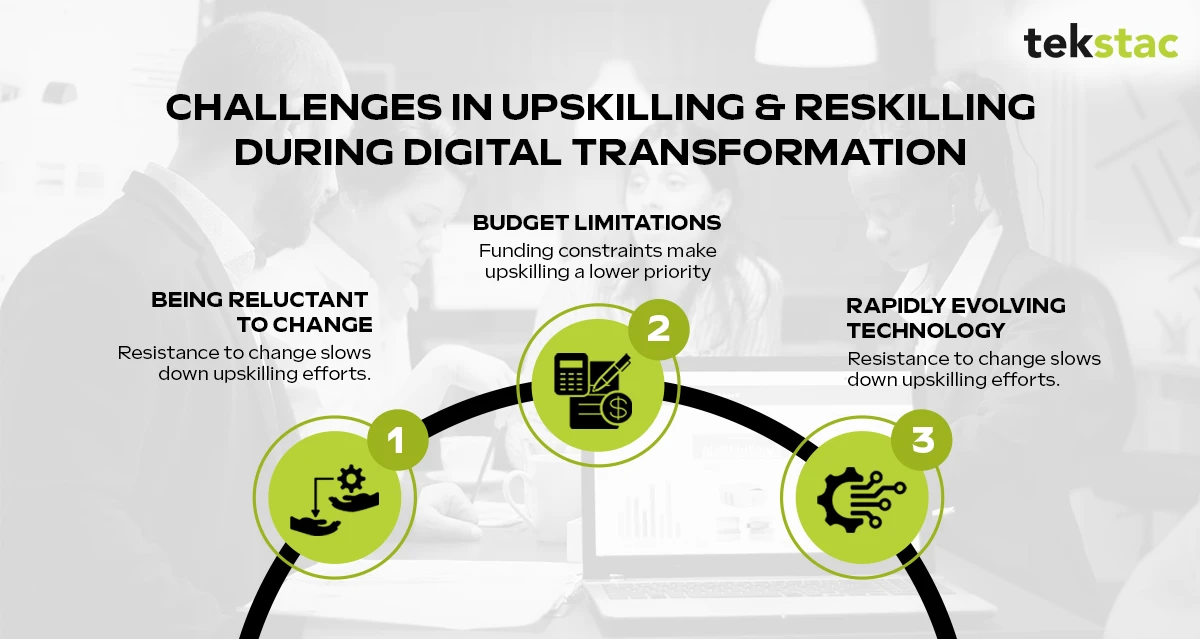
1. Being reluctant to change
One of the primary reasons organizations struggle while undergoing digital transformation is that employees may not welcome change or resist upskilling/reskilling efforts. This could be due to several reasons, such as feeling complacent with their existing role and skill set, lack of time, especially while balancing existing workload with training, and a fear of failure.
2. Budget limitations
When organizations undergo digital transformation, a significant portion of their budget is allotted to replacing legacy systems and digitizing operations. It leaves organizations, especially small and medium-sized enterprises, with strained budgets to allocate funds for upskilling and reskilling initiatives.
3. Rapidly evolving technology
With the fast emergence of technologies like Artificial Intelligence (AI), Augmented Reality (AR), and cloud computing, employees find it difficult to keep up with the pace at which they must undergo training. Also, skills required for particular tools or technology become obsolete when newer versions are released. These constant changes may overwhelm employees as they try to balance their day-to-day roles and responsibilities with upskilling and reskilling training.
Case studies — Successful digital transformation via upskilling and reskilling
Are you an organization aiming to upskill and reskill to facilitate digital transformation? Here are some organizations that have made the successful transition and an insight into how did they do it:
1. IBM
IBM launched its famous “New Collar Jobs” initiative in 2015 to reinvent its workforce and train them in emerging technologies like AI, cloud computing, and data science. This initiative was a game-changer for those without a college degree, as they could still receive training to develop skills in new-age technologies.
They trained their workforce in software development, blockchain, cybersecurity, AI, Data science and analytics, and cloud computing. This was instrumental in creating a diverse and larger talent pool, minimizing the need for external hiring, and meeting the market’s demands.
2. Nike
They transitioned from a traditional sports shoe business to a digitally driven client-centric ecosystem. Nike invested in training its employees on data analytics, predictive analytics, and customer segmentation.
Based on this, the employees worked on user data from apps like Nike Training Club and Nike Run Club to run highly targeted marketing campaigns and offer personalized client experiences. Employees also underwent training in e-commerce platform management, inventory management, and digital payment systems to increase digital revenue.
Leaders were also reskilled in adopting new-age technologies like Augmented Reality (AR) and Blockchain to create digital-first strategies.
Conclusion
Global digital transformation is forecasted to reach $2.8 trillion by 2025. This is an excellent indicator for organizations to prepare their leaders to create a sound vision and strategy for digital transformation. The onus lies with the leadership establishing continuous learning that encourages employees to upskill and reskill. Since digital transformation marks a cultural shift in an organization, leaders must guide employees through regular meetings, offer constructive feedback, resolve their concerns, and promote its benefits.
Reskilling and Upskilling benefit employees and the organization, promoting increased job satisfaction, increasing brand reputation, and creating an agile and versatile workforce.
Take an initial step in your digital transformation journey by assessing your employee’s digital skills and empowering them to stand out in a constantly evolving digital landscape.
Upskilling and Reskilling FAQs
1. What is the difference between upskilling and reskilling?
Upskilling enhances an employee’s existing skills to keep up with industry advancements, while reskilling trains them in new skills for a different role within the organization. Both are crucial for workforce adaptability and career growth.
2. How can AI help personalize the learning experience?
AI-based platforms offer personalized learning paths tailored to organizations goals, learning requirements, and performance.
3. What are some key takeaways from case studies like IBM and Nike?
Investing in training for emerging technologies, focusing on data analytics and customer experience, and reskilling leaders.
4. What are the benefits of upskilling and reskilling for employers?
Increased employee retention, improved workforce agility, enhanced brand reputation, and a larger internal talent pool.
5. What is digital upskilling, and why is it important?
Digital upskilling helps employees gain modern tech skills—like cloud computing or AI—ensuring they can contribute to digital transformation initiatives with confidence.
6. How do I start a digital upskilling training program?
Start by conducting a skills assessment, defining learning goals, and using AI-based platforms like Tekstac to deliver personalized, data-driven learning paths.
Top 10 Corporate Training Topics Every Company Should Cover in 2025
Why Corporate Training Topics Matter in 2025
Companies annually invest over $350 billion in corporate training. That’s quite an investment, but here’s the shocking reality: 70% of employees still feel they lack the skills to do their job well.
It only gets worse. For example, an ATD study reported that 62% of HR managers said their training programs did not meet the employee’s needs. Quite simply, most corporate training programs with good intentions and big budgets are off target.
To the leaders of L&D in tech, this is not a problem; it’s a challenge. Technology is always in development, and 2025 is going to be a sterner challenge in terms of keeping pace with the latest tech.
Staying relevant despite widespread changes in the corporate sphere is not about spending more on training; it’s about being smart about how you do it.
Are you focusing on the skills that matter most? Are you delivering training that future-proofs your workforce?
How do you ensure your team not just keeps pace but thrives in this ever-changing landscape?
The answer to these questions is prioritizing training topics that matter, beyond theory into real-world impact.
Top 10 Corporate Training Topics Companies Must Prioritize
Let’s take a closer look at the top 10 corporate training topics your company should cover in 2025 to close the skills gap and truly empower your workforce.
- MLOps Skills: Converting Machine Learning into Enterprise Value
- Robotics Field Engineering: The Next Frontier of Corporate Skills
- GPU Programming and Embedded Systems: The Building Blocks of AI Innovation
- AI-Driven Networking: The Missing Piece in Network Engineering Talent
- Marketing Ops & Analytics: The Data-Driven Backbone of Tech Marketing
- Data Engineering for SaaS Teams: Making Systems Seamless
- DevOps 2.0: Thriving in a More Specialized World
- Basics of Quantum Computing
- Leveraging SQL and Python to build non-technical roles into data-confident staff
- Generative AI: Redefining Creativity and Automation in Technology

1. MLOps Skills: Converting Machine Learning into Enterprise Value
L&D leaders in tech companies must prepare their workforce for the challenges of scaling machine learning models. This is where MLOps comes into the picture.
MLOps is a mix of machine learning, DevOps, and data engineering that helps businesses successfully deploy and manage AI solutions.
A perfect MLOps use case that shows how beneficial training your employees in these skills can be is that of Ocado.
Being one of the largest online supermarkets, Ocado needed robust yet scalable ML solutions for key challenges including fraud detection, supply chain optimization and personalized customer experiences.
Ocado successfully implemented MLOps to deploy and monitor ML models that improved fraud detection, reducing manual review times and securing transactions.
With the help of MLOps, Ocado created daily retraining pipelines for quick adaptability to changing data patterns.
They were also able to make accurate demand predictions, minimize food waste, and optimize delivery routes to ensure freshness while reducing fuel emissions.
Key Challenges this corporate training topic solves:
- Breaking down silos within teams: Often, data science and engineering teams operate in silos from one another. MLOps training bridges that divide by building a collaborative team approach.
- Real-Time AI Management: From forecasting customer purchase behavior to predictive maintenance for equipment, the AI solutions require overseeing and maintenance. MLOps prepares the organization for that.
- Avoid long-term costs: Poorly managed AI projects lead to inefficiencies. MLOps training prevents this with the teaching of sustainable practices.
2. Robotics Field Engineering: The Next Frontier of Corporate Skills
The industry-wide revolution in robotics will take place in healthcare, logistics, manufacturing, and beyond.
Training employees in robotics goes beyond mere programming; it is geared at nurturing all-around problem solvers capable of dealing with complicated machines and data.
Providing training in embedded systems programming, hardware maintenance, and troubleshooting can groom employees for career positions such as Robotics Operations Manager or Field Engineer and future-proof your organization.
Key challenges this corporate training topic solves:
- Bridging the talent gap: The boom in robotics jobs has resulted in a shortage of qualified professionals. Training can help upskill internal talent to meet this demand.
- Industry adaptation: Be it medical devices or warehouse automation; employees must learn how robotics applies across industries.
- Maximizing ROI on robotics investments: With businesses investing in robotics, training teams in this field becomes integral for efficiency and productivity. Otherwise, such investments may not pay off.
3. GPU Programming and Embedded Systems: The Building Blocks of AI Innovation
GPU programming and embedded systems are the driving force behind today’s most advanced technologies, from AI to self-driving cars.
Training in these areas arms employees with what they need to push the needle and prepare for the next wave of AI and high-performance computing.
Proper training can equip your team with the skills needed to manage the robust technologies of the future and derive the best results for your organization in 2025 and beyond.
Key challenges this corporate training topic solves:
- Keep up with AI trends: AI requires some serious processing power. It’s achievable with GPUs but teams need to know how to use them.
- Closing the skills gap: Few organizations can find people who have the necessary parallel programming or system optimization skills. Training solves this problem and thus provides a competitive edge to companies.
- Scaling IoT and robotics: Embedded systems are the heart of automation. Training is necessary to enable the employees to use embedded systems and create powerful, lightweight business solutions.
4. AI-Driven Networking: The Missing Piece in Network Engineering Talent
Networking is the silent binding force that holds all technology companies together. Everything from a simple flow of data to cloud services and remote teams runs on networking.
Here is where the problem lies: there are simply not enough good network engineers. Inevitably, this lack of people with such a crucial skill is beginning to make things a bit more difficult to manage for businesses as networks get increasingly complex, especially with cloud computing, IoT, and the modern work-from-anywhere approach.
This is a type of training that companies should look to impart to have resilient networks that run well, securely, and with efficiency.
As the bulk of modern day business relies on technology, network infrastructure has become critical in daily operations and data security.
If you are an L&D leader, your key training focus for this area should be to train employees to use AI-powered network tools.
This will help them proactively identify and address issues before they disrupt operations.
Also, focus on cloud-based networking courses that can train your team to connect hybrid cloud systems with in-house networks for seamless connectivity.
Additionally, train your team to build zero-trust security models to protect sensitive information from leaking through various access points.
Key challenges this corporate training topic solves:
- Talent Shortage: The availability of network engineers is low, but demand is high. Within this imbalance, delays and bottlenecks could lead to costly implications for business performance.
- Modern networks are more complicated: The technology setups of today, such as AI, cloud services, and hybrid work, have complicated things to a degree that the traditional skills for network management no longer apply. Hence, modern solutions are required rather urgently.
- Security Vulnerabilities: Poorly managed networks can expose an organization to cyber-attacks. Poor configuration of the network will provide a gateway for hackers and thus compromise the whole system.
5. Marketing Ops & Analytics: The Data-Driven Backbone of Tech Marketing
In many tech companies, marketing operations and analytics are unsung heroes. They work in the background, stitching together marketing and sales so that decisions can be data-driven rather than based on gut feeling. This is a very important but commonly overlooked role, especially in B2B tech companies where growing tech stacks and data complexity create chaos.
By training teams in marketing ops and analytics capabilities, technology companies can make informed, data-driven decisions that enhance performance by reducing inefficiencies and improve the alignment between marketing and sales efforts. This not only fosters current growth but positions companies for ongoing success.
Key challenges this corporate training topic solves:
- Inefficiency of Data: Too many businesses do not track data or have a reporting mechanism in place. With a lack of a correct framework, marketing can go awry with the money that gets lost in opportunities blown.
- Complexity of tech stacks: As a variety of different tools start to proliferate in the market, it is very difficult for marketing teams to stay above water. Knowledge which could help manage and integrate such systems is key in this process of streamlining marketing efforts.
6. Data Engineering for SaaS Teams: Making Systems Seamless
Think of SaaS as the circulatory system of modern tech: data flows are its lifeblood. But when these streams hit blockages or inaccuracies, real-time decision-making goes out of the window, teams lose faith in their tools, and the user experience suffers. Better training will make your employees more self-reliant and confident with regard to handling data pipelines. For example, an operationally competent team of experts can create a custom dashboard themselves that saves them hours of manual reporting. This will increase efficiency by empowering the teams to make wiser decisions faster.
Key challenges this corporate training topic solves:
- Spotting and fixing errors: Imagine a marketing dashboard pulling incorrect data because of a tiny error in a SQL query. It could lead to bad campaigns and wasted budgets. Employees need to catch these errors fast.
- Multiple tool connections: Most SaaS teams are forced to work with CRMs, analytics platforms, and databases. A disconnect between these can lead to inefficiencies.
- Ensuring data accuracy: For SaaS companies that depend on live dashboards, the implication of bad data is missed opportunities or lousy decisions.
7. DevOps 2.0: Thriving in a More Specialized World
DevOps has evolved from the “jack-of-all-trades” engineer to a model that embraces specialization. Whereas early DevOps teams depended on one person handling everything from infrastructure through CI/CD pipelines, the complex tech ecosystems of today ask for experts in specific areas, such as Kubernetes or monitoring systems.
Training is of prime importance to help your team adapt to these changes while still collaborating effectively. Think of an application crashing in your tech company just because the underlying infrastructure was unable to support sudden surges in traffic. With the right DevOps training, your team can manage this issue and quickly create spin-ups of new servers using Kubernetes ensuring uptime without glitches. Specialization in key tools will not only avoid downtime but help your team improvise faster and work better.
Key challenges this corporate training topic solves:
- Operational scaling: It is slow and subject to human error to scale infrastructure without specialized skills.
- Breaking down silos: With one person handling all development-related tasks “knowledge silos can occur. That’s why specialized training within the broader DevOps sphere is necessary.
- Keeping up with tools: Terraform, Prometheus, and Kubernetes have become the standard tools in the industry and improper knowledge of using these tools can hold your team back.
8. Basics of Quantum Computing
Quantum computing can sometimes sound like the stuff of science fiction, but in truth, it is closer to reality than most people think. From solving long-stemmed problems to enhanced encryption, quantum technologies stand ready to disrupt everything from healthcare to cybersecurity. L&D teams have to get ahead of this curve to help their organizations prepare for this seismic shift.
Now, put yourself in a situation where your company is among the very first to adapt quantum-safe encryption as part of its cybersecurity strategy. This will give you an edge over your competition and further reduce the potential risk of being left behind. To the L&D leaders, quantum computing training means, your teams are future-proof, so you are positioned as early adopters in the tech space.
Key challenges this corporate training topic solves:
- Building awareness: Quantum computing may not be mainstream, but the companies that start preparing now will have a huge advantage.
- Interdisciplinary collaboration: Quantum computing will require physicists, computer scientists, and engineers working in teams across traditional disciplinary divides. With quantum computing training, you can enable your employees to collaborate and work on this futuristic tech for the benefit of your company.
9. Leveraging SQL and Python to build non-technical roles into data-confident staff
Data is the backbone of any tech company’s success, but just imagine a situation wherein both your marketing and operations teams don’t need to knock the doors of their data counterparts. By teaching basic skills in SQL and Python within non-technical positions, you make every team more agile, increasing the productivity of specialized manpower and creating an atmosphere where every team is self-sufficient and empowered.
For instance, a marketing professional who can write a simple SQL query to analyze campaign performance doesn’t just save time but contributes to faster, data-driven decisions.
Key challenges this corporate training topic solves:
- Data Bottlenecks: Most of the time, overworked data teams can’t keep up with even the basic requests, thus delaying decisions across departments.
- Missed opportunities: Without self-service data capability, teams risk acting too slowly on critical insights.
- Complex data systems: Most modern tech organizations have a very intricate ecosystem of data that requires navigation by non-technical roles.
10. Generative AI: Redefining Creativity and Automation in Technology
While GenAI is the talk of the town with every company’s focus honed in on its potential, it’s a corporate training topic worth reiterating in this list. GenAI has become a cornerstone of innovation that allows technology companies to reimagine creativity, productivity, and automation. From content creation to the generation of synthetic data for testing, GenAI lets organizations reimagine workflows and build smarter, faster solutions.
Training teams to leverage GenAI means ensuring your business stays ahead in a rapidly evolving landscape, driving efficiency and innovation at every level. Automation through this technology is less about machines replacing humans; instead, it is more about empowering people, giving them the opportunity to get more done with much less sweat.
Key challenges this corporate training topic solves:
- Most of the employees are unable to adapt AI workflows into their current jobs, and this is one of the reasons for underutilization of the technology.
- Ethical concerns: AI-generated content or data, raises concerns regarding bias, misinformation, and intellectual property that can be addressed with proper training.
- Skills gaps: Teams need to understand not only how to use GenAI tools but also how to validate outputs and ensure alignment with business goals.
These corporate training topics are at the heart of true talent transformation—helping companies move beyond filling skill gaps to building future-ready teams that can adapt and thrive.
Conclusion: A Smarter Approach to Corporate Training Topics
As you navigate through these advanced training topics that can help your organization in 2025 and beyond, one challenge remains universal: how to ensure practical, on-the-job applicability of these skills? Additionally, how to ascertain that your employees are properly engaging in the training and are preparing ideally for the organizational goals you have in mind? This is where platforms like Tekstac are redefining corporate skilling.
Such platforms deliver real-world based training, assess employees for role-specific competencies, and help you analyze their progress using advanced data. The best part? You can scale your corporate learning programs across large teams without compromising on depth. If you are an L&D leader wanting to deliver result-oriented tech training across various verticals effectively and at scale, consider investing in a corporate training platform like Tekstac.
FAQs on Corporate Training
1. How do corporate training topics improve employee performance?
Corporate training topics boost performance by closing skill gaps, improving confidence, fostering adaptability, and aligning employee abilities with evolving business goals.
2. How to choose the right corporate training topics for my workforce?
Identify current skill gaps, align training with business objectives, consider future industry trends, and prioritize topics offering practical, measurable impact on performance.
3. Which corporate training topics are best for tech companies?
Tech companies benefit most from training in AI, MLOps, DevOps 2.0, data engineering, robotics, and generative AI for innovation, efficiency, and competitiveness.
4. What are the types of corporate training?
The main types of corporate training include onboarding, technical skills, soft skills, compliance, leadership development, product training, and diversity programs.
Why Gamified Learning Is the Future of Employee Development?
Gamified learning introduces new opportunities for advancing workplace learning by incorporating gaming features into training programs. Organizations reward and motivate their employees by offering engaging lessons that include competition, objectives, and other elements that increase engagement. This approach changes the attitude towards learning, making complex concepts and skills needed for a workplace faster and easier to internalize.
Changing circumstances in workplaces today render standard employee training methods ineffective. Development activities are transformed into engaging and fulfilling experiences. Leaderboards and achievement badges motivate employees to care about their development and work together to achieve results.
What is a Gamified Learning
Gamified learning is an approach in which gaming mechanics like scores, levels, rewards, and challenges are incorporated into the learning environment. This strategy renders the learner’s interactive experience enjoyable and will likely attract and retain attention. By leveraging natural human motivation instincts, gamified learning makes learning more interesting and less repetitive.
This approach is implemented across various domains to enhance engagement and retention. Gamification enables individuals to acquire key skills more interactively. Recognizing progress through levels or rewards cultivates a sense of achievement, making the learning experience both motivating and effective.
Why Is Gamified Learning Effective?
Because it speaks to how we’re wired—everyone loves a little friendly competition, the satisfaction of hitting a goal, and getting feedback right when it matters. That’s what makes gamified learning feel less like training, and more like something you actually want to do.
How Gamified Learning Aligns with Modern Workplace Needs
1. Employee Engagement and Motivation
According to Gallup, employee engagement remains a critical challenge in today’s workplaces, with only 34% of employees being actively engaged. Traditional training methods often fail to capture employees’ attention, leading to low motivation and participation.
Gamified learning has proven to be an effective way to tackle this problem, significantly increasing employee engagement. A recent study revealed that 89% of employees would work harder if their tasks were more gamified.
2. Retention and Knowledge Retention
Gamified learning not only boosts engagement but also enhances knowledge retention. PwC’s study found that 75% of employees are more motivated to learn when training involves game-like elements. According to Learning, it can improve retention by up to 60% compared to traditional methods.
This is largely due to techniques like active recall and spaced repetition, which have proven to be highly effective in helping employees retain information and apply it in real-world situations.
3. Impact on Learning Outcomes
Gamified learning also significantly impacts learning outcomes. A Forbes report found that 83% of employees believe training would be more effective with game elements such as rewards and points. When paired with microlearning, which involves short and focused learning modules, gamification offers employees flexibility and engagement.
According to McKinsey, this combination has become a trend in employee training. It allows learners to access material at their own pace while receiving immediate feedback, which enhances the overall learning experience.
4. Cost Effectiveness and Return on Investment
The increasing investment in gamified learning highlights its cost-effectiveness. A report by Global Industry Analysts projects the learning market to grow to $30.7 billion by 2025, as businesses recognize its value. The Brandon Hall Group found that companies implementing gamified learning saw a 14% increase in employee engagement and a 22% boost in performance.
5. Support for Continuous Learning
In today’s fast-paced business environment, continuous learning is more important than ever. LinkedIn’s Workplace Learning Report found that 94% of employees would stay longer at a company that invests in their development. Learning supports this by offering engaging, on-demand content that encouraging employees to keep learning.
With the rise of Learning Experience Platforms (LXP), gamified elements like badges and leaderboards are being integrated to keep employees motivated and provide a more personalized learning experience that fosters lifelong development.
6. Skill Development for Future Challenges
As technology evolves, the need for reskilling and upskilling becomes more pressing. Deloitte’s report revealed that 47% of organizations plan to invest in upskilling programs to address this challenge. Learning is a powerful tool for helping employees develop new skills quickly and efficiently.
The World Economic Forum predicts that by 2025, 85 million jobs will be displaced by automation, but 97 million new roles will emerge that require different skill sets. Gamified learning can equip employees with these necessary skills in an interactive, adaptable way at a much faster clip.
Challenges and Limitations of Gamified Learning
Challenges of gamified learning include upfront costs and the problem of translating ‘hard to teach’ content. This is because, on the one hand, rote memorization of facts for subsequent incentives may occur, and on the other hand, not all workers may embrace the technology.
High Initial Investment
Designing a learning program requires substantial resources, such as time, money, and technical expertise, making it costly, particularly for small businesses. For example, SAP implemented a gamified platform with features like leaderboards and challenges. While the initial investment was high, the program eventually paid off by significantly improving employee engagement and skill development.
Overemphasis on Rewards
In some cases, employees may focus more on earning points, badges, or rewards rather than truly understanding the material. A healthcare organization that introduced gamified training faced this issue, where staff prioritized achieving high leaderboard rankings over absorbing critical patient care concepts. They adjusted the program to emphasize real-world application alongside rewards to resolve this.
Not Suitable for All Content
Certain types of training, such as those involving highly technical or conceptual topics, may not quickly adapt to gamification. For instance, a multinational bank’s financial compliance training program struggled to gamify complex regulatory topics due to their detailed and structured nature. Instead, they supplemented traditional methods with small gamified elements to keep learners engaged.
Accessibility Issues
Gamified learning systems must accommodate those with disabilities or those in areas with limited access to technology. A global NGO discovered that its e-learning gamification program struggled to reach employees in remote regions due to connectivity issues. By creating simplified offline modules, it ensured inclusivity and broader participation.
Why Gamified Learning is Transforming Employee Development

- Increased Participation and Drive: If there are rewards, challenges, or even progress bars, employees’ attention will be captured throughout the learning process. The feeling of accomplishment when one gains points or gets to the next level helps employees extend their desire for points to learning, thus making training a positive experience.
- Better Retention and Practical Use of Knowledge: It is vital to ensure active participation, and when an employee is taken through gamification, he/she has concepts actively adjusted in his/her mind. This practical approach is more effective than the conventional learning process, where information is delivered through reading or perceiving by ear.
- Fosters Healthy Competition: Gamified learning involves using leaderboards and team challenges, thus making the respective learning atmosphere highly competitive. These activities make other employees perform better than the rest, which can only mean increased productivity and performance. On the same note, competition is healthy but not cutthroat in that organizations fight each other in battles.
- Development of Critical Skills: Gamified learning involves solving a logical problem together with some decision-making skills. These exercises try to mimic real-life scenarios so the employees can hone their skills in areas that do not involve much risk. Finally, a top-quality tool empowers employees to solve multifaceted issues and gain experience while working within the company.
- Personalized Learning Experience: The principal benefit of gamification lies in its potential to deliver more targeted content from which participants’ needs can be derived. If employees advance through the company in a game-like fashion, the learning curve can also increase or decrease in difficulty. This makes learning effective for every employee, with the training relevant to their skills and the development that they can accomplish.
Conclusion: Gamified learning
Gamified learning offers a fresh and innovative approach to training and development, blending engagement with measurable outcomes. The real value lies in designing gamified programs that align with strategic goals and deliver meaningful skill enhancement.
It’s crucial to strike a balance—integrating game mechanics that motivate employees while ensuring the training content fosters long-term capability development. By focusing on outcomes rather than just rewards, organizations can create impactful training experiences that drive productivity, foster growth, and align with business objectives.
Ready to transform your workforce?
Explore how Tekstac’s gamified learning programs can increase employee engagement and boost performance by up to 22%.
👉 Request a Free Demo and start building smarter teams today.
Gamified Learning FAQs
1. Does gamified learning require expensive technology?
Not necessarily. Gamified learning can be implemented using basic tools like quizzes, points systems, or leaderboards integrated into existing learning platforms. While advanced tools can enhance the experience, effective gamification doesn’t always rely on high-tech solutions.
2. Is gamified learning suitable for all types of learners?
Gamified learning appeals to many learners due to its engaging nature. However, tailoring it to fit the specific audience is essential. Learners have varied preferences for challenges and rewards, so customization is key to maximizing its effectiveness.
3. How can gamified learning measure success?
Success in gamified learning can be measured through learner participation rates, progress tracking, test scores, and feedback. Monitoring engagement levels and retention rates also helps assess the effectiveness of the gamified approach.
4. Make Learning Count with Tekstac
Elevate skills, boost collaboration, and empower your team with tekstac gamified training solutions. From onboarding to upskilling, we design impactful learning experiences that drive real results. Partner with Tekstac today to build a smarter, stronger workplace!
Top 5 Key Features to Look for in an Effective Upskilling Platform
Why Businesses Need Enterprise Upskilling Platforms for Digital Transformation
The World Economic Forum’s Future of Jobs Report predicts that technological advancement will create 69+ million new jobs and displace 83+ million jobs by 2027. This shift presents organizations with an urgent challenge: upskilling and reskilling the workforce with future-ready digital skills.
Gartner’s 2024 HR Leadership Priorities report highlights that 44% of employees lack the digital skills needed for their current and future roles. As the disparity between current capabilities and future demands grows, investing in platforms that deliver scalable, impactful learning solutions is no longer optional—it’s essential.
The rise of remote and hybrid work models has transformed employee learning preferences. Organizations now seek skills development & learning platforms that combine flexibility with measurable impact on both workforce capabilities and business outcomes.
Let’s explore the five critical features that define an effective enterprise upskilling platform, helping decision-makers build future-ready teams.
1. Industry-Aligned Learning Content for Upskilling
Any platform that works well has learning content at its core. Employees need to be able to reach a lot of different resources that are relevant to their jobs, industries, and skill sets.
LinkedIn’s 2024 Workplace Learning Report reveals that 91% of L&D leaders prioritize helping employees learn new skills to deal with new problems, with industry-specific training showing the highest impact on employee performance.
Modern platforms must offer:
- Customizable learning paths aligned with industry trends
- Regular content updates reflecting technological advances
- Integration capabilities for organization-specific materials
Business Impact: Tekstac’s customizable learning paths have helped organizations achieve measurable improvements in employee skill acquisition through industry-specific content delivery.
2. Hands-on Practice Environments
Effective skill development requires practical application. ATD’s 2023 State of the Industry Report indicates that organizations investing in experiential learning see a 42% higher employee proficiency rate compared to traditional training methods.
For example, a cybersecurity sandbox can allow users to:
- Simulate phishing attack scenarios in a controlled environment
- Practice incident response procedures without system risks
- Test security configurations in isolated environments
Tekstac’s integrated upskilling lab environment enables real-time practice across various technologies, from programming languages to cloud infrastructure, ensuring skills transfer directly to work scenarios.
3. AI-Powered Personalization
According to Deloitte’s 2023 Human Capital Trends report, organizations using AI-driven learning platforms report 37% higher employee engagement in development programs. Modern upskilling platforms powered by AI can:
- Analyze employee skill assessments to identify knowledge gaps
- Recommend personalized learning paths based on career goals
- Track progress and adjust content difficulty automatically
Example: An AI-driven system might identify a junior developer’s potential for cloud architecture roles and create a customized learning path incorporating both technical and architectural skills.
4. Actionable Data Insights
Leaders in learning and development (L&D) may find it hard to show stakeholders how well skills development and learning programs work. Enterprise upskilling platforms with advanced analytics dashboards show how employees are growing how they are learning new skills, and how the company is doing. These solutions help people make better decisions by connecting learning results to employees’ productivity and performance.
Research from Deloitte shows that companies that use learning data will see a 30% rise in the productivity of their employees.
Businesses should make sure that the platform does more than just collect data. It should also give them actionable information, like insights on how ready a team is to learn new skills or how engagement has changed over time.
5. Enterprise-Level Security and Scalability
The WEF Future of Jobs Report 2023 indicates that 75% of organizations are accelerating their digitalization plans, requiring platforms that can securely scale while maintaining data protection standards. Key requirements include:
- SOC2 Type II compliance and ISO 27001 certification
- End-to-end data encryption
- Single-tenant architecture for enhanced security
- Support for hundreds of thousands of concurrent users
Security Insight: Single-tenant platforms provide dedicated infrastructure for each client, preventing data cross-contamination and enabling customized security policies. This is crucial for sectors like healthcare and finance.
How to Choose the Best Platform for Upskilling for Your Business
To pick the right upskilling platform, you need to investigate its features and check its ability to scale and meet your company’s needs. “What should I prioritize when investing in an upskilling platform?” is a question that business and L&D leaders often ask.
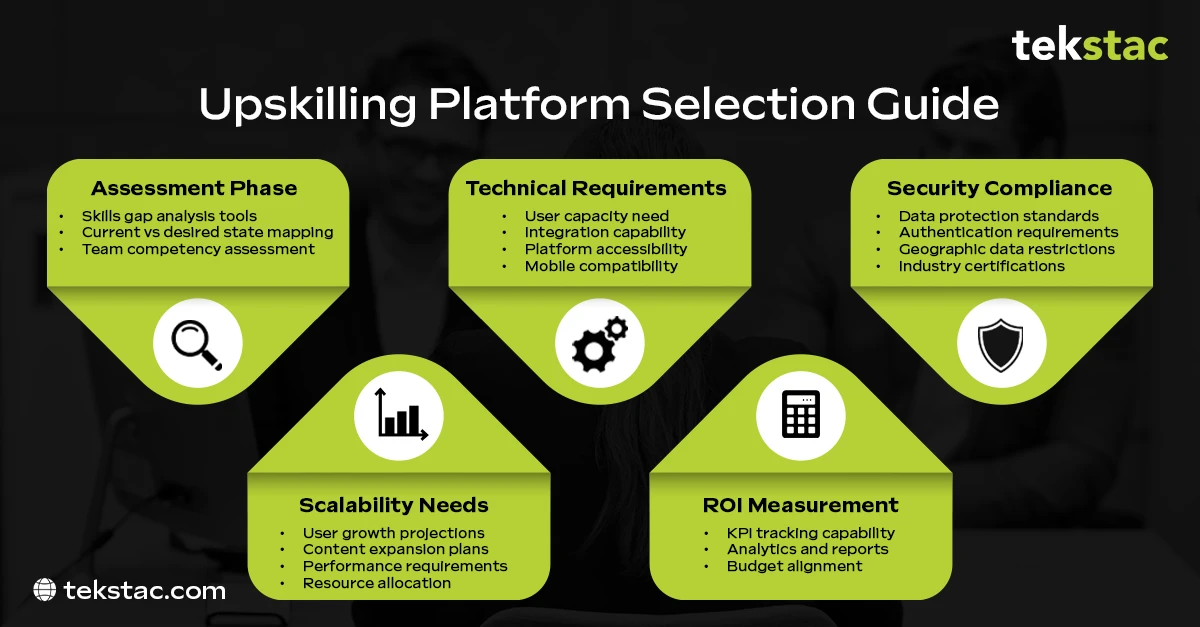
One of the most important steps is to focus on platforms offering comprehensive solutions for technology and soft skills. Such skills as leadership, communication, and emotional intelligence are critical for holistic workforce development.
Do not forget to check for the integration with your existing HR tools and systems. A platform that supports integration with learning management systems (LMS) guarantees a smooth workflow and allows you to track learning outcomes in real time.
Business tip: If you want to get the most out of the money you spend on training, pick options that have strong reporting and integration capabilities. Modern platforms like Tekstac combine these essential features with enterprise-grade security and scalability.
The platform’s comprehensive approach includes rich learning content, hands-on labs, and advanced analytics, enabling organizations to build future-ready teams efficiently.
What is the ROI of Investing in Upskilling Platforms?
For many organizations, the question isn’t whether to invest in upskilling but how to measure its return on investment (ROI). When evaluating ROI, consider both tangible and intangible benefits, such as increased employee productivity, reduced turnover, and internal talent mobility to fulfill talent needs.
Platforms with advanced analytics and predictive capabilities help track metrics such as time to competency, post-training performance, and overall engagement. This data supports decision-making and helps secure buy-in from stakeholders by demonstrating measurable impact.
Hint for businesses: Choose platforms with built-in ROI measurement tools to link learning outcomes directly to business goals and performance metrics.
Are you ready to transform your upskilling and reskilling strategy to future-proof your workforce? Contact our experts to discover how Tekstac’s enterprise-grade upskilling platform can accelerate your team’s growth.

